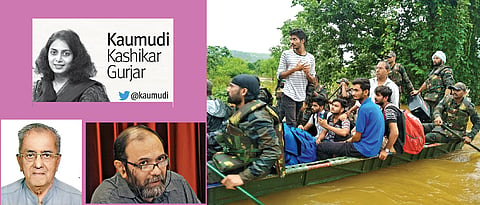

Due to excessive rainfall this year, several parts of the state including Pune have witnessed human and property loss due to flooding. Despite repeated warnings about the changing rainfall pattern, the administration has been caught napping in most of the places.
When we speak about the city, Pune received 189.02 mm rainfall in just eight days of August causing inundation in several parts of the city like Aundh, Baner, Balewadi and Vitthalwadi which were not part of the blue line.
While the administration is busy probing the reasons for this catastrophe, city planners, architects and environmentalists who spoke to Sakal Times, said that the rampant dumping of debris in nalas and perfunctory cleaning of stormwater drains is responsible for inundation in the parts which were constructed after taking due permission from the administration. However, these issues may appear very local but they highlight how warnings were grossly ignored by the civic body.
While Pune city has indeed received 742 mm seasonal (June 1 to August 8) rainfall which is much more than the normal expected rainfall- 361.3 mm. But it was in 2009, the Government of India had asked all state governments to prepare a plan on how they are going to face the effects of climate change. Government of Maharashtra had then asked The Energy and Resources Institute (TERI) to prepare an exhaustive report. The report was submitted to Government of Maharashtra in 2014. Architect and environmental activist Sarang Yadwadkar emphasised that the report warned about the changes in annual rainfall pattern. It had stated that rainy days would go on decreasing and occurrences of cloudburst would be frequent.
He said that there is no doubt that the rainfall was unprecedented but it is very irresponsible on the part of government that they did not expect it. He added that TERI report had mentioned about augmenting stormwater drainage system by 15 per cent. He pointed out that the rivers and streams, which are apart of the natural stormwater drainage system, are being encroached upon. The encroachments in riverbeds contribute 90 per cent to this catastrophe but the failure in the proper management of solid waste is also causing flooding in urban parts.
Sharing that inundation in the parts that were not part of the blue line points out administrative failure, Yadwadkar told Sakal Times that this issue needs to be looked through a broader perspective, “Due to encroachments in the river, the blue line becomes obsolete. Because of the deposition, there is a reduction in the cross-sectional area of the river resulting in the level of the water going much higher. Due to this, water is spread on both sides.”
He added that due to concretisation, the surface runoffs are increasing causing flash floods. To avoid this, one needs to strengthen the capacity of tributaries but instead of that, nalas and rivers are being encroached upon and their course is also being changed.
Former Assistant Planning Director Ramchandra Gohad told Sakal Times, “For the implementation of abatement of pollution of Mula and Mutha rivers’ project, we have obtained Rs 900 crore from Japan International Cooperation Agency (JICA).” He added that the structures built alongside the river should be strong enough to withstand the hydraulic pressure of the water. He said that the details of this project are still not made known neither to common people and nor to the experts. Gohad recounted that beautification of the riverbank done during the tenure of PMC Commissioner SG Barve, washed away during the floods 1952-53. The Lakdi Pul and stone pillars of Nava Pul too were washed away during the floods of 1961.
Speaking about the incidents of waterlogging and water entering into areas that were not part of the blue line, Gohad said that this indicates that the stormwater drainage system has become infective. Thorough cleaning of stormwater drains will ensure that surface runoffs do not spread on roads or water does not enter residential areas.
Gohad added this work should be completed in April and May. He added that after heavy downpour in 2005, the PMC had appointed an agency that said there were 234 nalas. If debris is being dumped indiscriminately, then, these waterways will be clogged causing waterlogging at multiple spots in the city.
